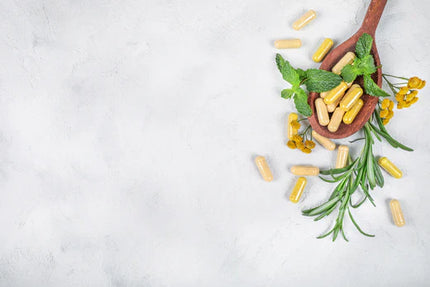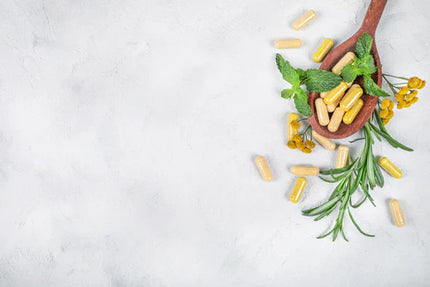Herbs That May Assist
Turmeric
Curcuma longa, rhizome dry, as BCM-95™ Turmeric
Boswellia
Boswellia serrata, gum oleoresin dry, as BosPure ® Boswellia
Devil’s claw
Harpagophytum procumbens, root dry
Jamaica dogwood
Piscidia piscipula, stem bark dry
Actions
- Anti-inflammatory
- Analgesic
- Reduces tissue damage
Clinical Applications
- Osteoarthritis
- Rheumatoid arthritis
- Lower back pain
- Neuralgia/neuropathic pain
Clinical Overview
Chronic inflammation is a multi-stage process occurring within the body that can significantly impact an affected patients’ quality of life. Traditional evidence suggests there are several herbs that are particularly beneficial for chronic inflammation and pain including turmeric, boswellia, devil’s claw and Jamaica dogwood. Modern research has confirmed the traditional use of these herbs; showing how they affect the inflammatory cascade at multiple points (Figure 1), culminating in a reduction of inflammatory mediators such as prostaglandins (PGs). BCM-95™ Turmeric and BosPure ® Boswellia are specific herbal extracts that possess substantial anti-inflammatory benefits. Notably, they have been demonstrated to be as effective as pharmaceutical anti-inflammatory medications. [1] In addition, turmeric, devil’s claw and Jamaica dogwood provide analgesic activities. The combination of these properties provides pain reduction in conditions such as osteoarthritis (OA) and rheumatoid arthritis (RA). Furthermore, devil’s claw displays particular benefits in significantly reducing lower back pain in patients. [2] Traditional use of Jamaica dogwood highlights a long history of use for neuralgic afflictions and pain, being highly valued by traditional herbalists for the plant’s powerful analgesic properties. [3],[4],[5]

Figure 1: BCM-95™ Turmeric and devil’s claw to treat chronic inflammation addresses all areas of the inflammatory cascade.
Background Information
The Inflammatory Response
Inflammation is the body’s natural response to deal with injury or threat. When cells and/or tissues are disturbed, chemical signals trigger the immune system to mount an inflammatory response in order to neutralise the threat and restore function.
The inflammatory process consists of two phases – the onset and the resolution. During the onset phase, tissue resident macrophages sense damage and attract neutrophils to the site. In an attempt to remove the threat, neutrophils mount the initial inflammatory response and also attract serum monocytes, which further amplify the inflammatory reaction. Ordinarily, inflammation should be an acute response that subsequently resolves. However, situations of long-term, unresolved inflammation results in tissue destruction that can be inextricably linked to many chronic conditions, including vascular disease and metabolic syndrome, as well as rheumatological and neurological diseases.The tissue destruction that results from chronic inflammation manifests as joint degeneration in conditions such as OA and RA, or the gastrointestinal tissue breakdown seen in Crohn’s disease. Chronic inflammation, therefore, not only contributes to the progression of these diseases, but significantly impairs the quality of life in those living with inflammatory conditions.
Similarly to inflammation, physiological pain may be viewed as serving an important protective function; however, it can become pathological when the underlying drivers are not addressed. The sensation of pain requires activation of peripheral nociceptors (pain-sensing nerves), and the interpretation of that signal within the central nervous system (CNS). Nociceptors are specialised to detect stimuli that are objectively capable of damaging tissue, and subjectively perceived as painful. [6]
Pain
Nociceptors can be activated by strong stimuli (e.g. trauma or increased exertion), as well as by endogenous inflammatory mediators such as prostaglandin E2 (PGE2), tumour necrosis factor-alpha (TNF-α) and interferon gamma (IFN-γ). When chronic pain becomes pathological, it may be amplified and become more complex, resulting in hyperalgesia (where individuals experience an abnormally high sensitivity to pain), as well as allodynia (where typically non-painful stimuli are now perceived as being painful). [7]
These forms of pathological, persistent pain are characterised by long-term increases in synaptic glutamate signalling in nociceptive pathways, referred to as central sensitisation. [8] As such, reducing this signalling offers potential therapeutic benefits when managing persistent neuropathic and inflammatory or joint-related pain.
A lack of inhibition, primarily from gamma aminobutyric acid (GABA), the main inhibitory neurotransmitter for the CNS, is also a contributor to maintaining pain states. [9] Therapies that promote GABA production, or have an agonistic effect on the GABA receptor, may therefore also be useful in the management of chronic pain.
Tissue Damage and MMPs
Matrix metalloproteinases (MMPs) are proteolytic enzymes that degrade the extracellular matrix (ECM), the material that surrounds and supports cells in all tissues. MMPs function primarily to break down old, damaged tissue post injury, and to facilitate tissue remodelling, healing and new tissue growth. However, excessive MMP activity is known to drive tissue damage in inflammatory disease. For example, MMP-1 and MMP-113 are key players in the disease process in both OA and RA, contributing to the destruction of cartilage, tendon and bone. [10] MMP activity releases what are referred to as danger-associated molecular patterns (DAMPs), which are themselves a stressor and which drive chronic inflammation.
Herbal Extract Quality MattersBCM-95™ Turmeric is a proprietary form of turmeric extract that enhances bioavailability by 700%, while retaining the natural resins and essential oils found in turmeric root. The specific process used for the manufacture of BCM-95™ Turmeric allows the potent constituent curcumin to be concentrated; whilst the fibre, starch and protein from the turmeric root is removed. However, this process leaves all other naturally occurring active metabolites preserved in the finished product. Not only does this technique significantly increase bioavailability, but the resulting curcumin remains combined with the large range of compounds that occur naturally within turmeric root and offer synergistic effects. BosPure ® Boswellia is a proprietary herbal extract created from wild-crafted gum resin and, significantly, containing not less than 70% organic acids. The key components in BosPure ® are ~10% 3-O-acetyl-11-keto beta-boswellic acids (AKBA), 24% to 33% acetyl beta-boswellic acids, along with 5% to 12% acetyl alpha-boswellic acids. |
Actions
Anti-inflammatory
Curcumin has broad anti-inflammatory activities, decreasing many inflammatory mediators. Laboratory studies have identified a number of different molecules involved in inflammation that have their activities reduced by curcumin, including phospholipase, lipoxygenase (LOX), cyclooxygenase–2 (COX-2), [11] leukotrienes (LTs), thromboxane, PGs, nitric oxide (NO), collagenase, elastase, hyaluronidase, monocyte chemoattractant protein-1, interferon-inducible protein, TNF-α, and interleukin-12 (IL-12). [12]
In vitro studies indicate that curcumin can inhibit these inflammatory mediators via upstream action, including preventing the activation of nuclear factor kappa-B (NFĸB). NFĸB is a key inflammatory mediator that is sequestered in an inactive state in the cytoplasm by a family of proteins called IĸB (inhibitor of ĸB). Activation of NFĸB is achieved via phosphorylation of IĸB through the activity of a kinase called IĸB kinase (IKK). Curcumin has been found to prevent the activation of NFĸB via inhibition of the activity of IKK. [13] Additionally, curcumin has direct inhibitory effects on the enzyme 5-LOX. [14]
Boswellia also has significant anti-inflammatory effects, and appears to, at least partly, achieve this via inhibition of 5-LOX. AKBA (one of the boswellic acids) has been shown to inhibit the production of LTs by this enzyme. [15] It achieves this via the allosteric regulation [†] of 5-LOX, resulting in its inhibition. [16] Additionally, boswellia exerts activity further up the inflammatory cascade. Similarly to curcumin, AKBA inhibits the activation of NFĸB, [17] achieving this via IKK inhibition, the mechanism of which involves the suppression of Akt (a kinase required to activate IKK). [18]
In addition, the major active constituents of devil’s claw, harpagosides, have been shown in animal and in vitro models to reduce a number of proinflammatory molecules including PGs, LTs and NO. This is achieved through the partial inhibition of proinflammatory enzymes including COX-1, COX-2 and NO-synthase; validating this herb’s traditional use as an anti-inflammatory agent. [19]
Analgesic
Beyond its anti-inflammatory actions, curcumin also demonstrates antinociceptive activity. Nerve injury and inflammation can activate glial cells (such as astrocytes and microglia), which in turn activate multiple intracellular signalling pathways in neurons, including the mitogen activated protein kinase (MAPK) signalling pathway. Curcumin has been found to significantly attenuate nerve injury-induced neuropathic pain by inhibiting astrocyte hypertrophy in the spinal dorsal horn and phosphorylation of the MAPK signalling pathway. [20]
In addition, devil’s claw provides significant analgesic effects. In experimental studies, devil’s claw reduced pain sensations in the brain by increasing GABAergic and opioid activity, while reducing glutamate signalling. [21] In an animal study using a model of adjuvant-induced arthritis, devil’s claw demonstrated anti-inflammatory and analgesic properties, reducing arthritic pain and inflammation. [22]
Another traditional analgesic herb, Jamaica dogwood, is thought to exert this effect through a number of different mechanisms. Firstly, it has been shown to exhibit antispasmodic effects; this ability to relieve or suppress spasm of smooth muscle can assist in pain relief. [23] Jamaica dogwood may also decrease pelvic pain by improving blood flow (thereby reducing ischaemia), as well as general pain via the inhibition of enzymes involved in inflammation. [24]
Reduces Tissue Damage
Boswellia inhibits the cartilage degrading enzyme MMP-3. [25] It also prevents the decrease in glycosaminoglycan levels, which are essential for cartilage repair. [26] Interestingly, non-steroidal anti-inflammatory drugs (NSAIDs) have been shown to reduce glycosaminoglycan synthesis and accelerate cartilage damage, [27] whereas boswellia has been found to be similarly effective as NSAIDs, without the risk of accelerating cartilage damage. [28]
Moreover, in vitro studies suggest that curcumin can reduce tissue damage. It inhibits the production of MMP-3, MMP-9 [29] and MMP-13 and also restores type-2 collagen and glycosaminoglycan synthesis in human chondrocytes. [30] Additionally, devil’s claw was found to have a chondroprotective effect via inhibiting MMPs in an animal model. [31]
Clinical Applications
Osteoarthritis
A study compared a combination of BCM-95™ Turmeric and BosPure ® Boswellia with a selective COX-2 inhibitor for safety and efficacy in the management of OA (Figure 2). Twenty-eight male and female patients with OA received 17.5 g turmeric and 3 g boswellia twice daily for twelve weeks. Over eight visits, joint pain symptoms and walking distance capability were scored. Patients were also clinically examined for joint tenderness, crepitus, swelling, range of movement, thigh measurements, warmth and gait. The BCM-95™ Turmeric and BosPure ® Boswellia combination was found to be more effective than the COX-2 inhibitor for OA symptoms, particularly pain, walking distance and joint tenderness; and as effective as the COX-2 inhibitor for crepitus and range of movement. [32] This study showed that 92.85% of patients treated with BCM-95™ and BosPure ® demonstrated an improvement or had no joint line tenderness compared with 78.57% of patients given the COX-2 inhibitor.

Figure 2: Changes in moderate joint pain when using BCM-95™and BosPure ® compared to the use of a COX-2 inhibitor. [33]
In addition, boswellia has demonstrated great therapeutic potential for the management of OA. A small, but well-designed controlled crossover trial (n=30) carried out in 2003, investigated the use of boswellia extract for knee OA. The boswellia extract contained a minimum of 40% boswellic acids, including 6.44% AKBA. Patients received this extract at a dose of 333 mg/three times daily (providing 25.73 mg/day AKBA) or placebo for eight weeks. The results showed those in the boswellia treatment group had significant improvements in pain, walking distance and range of motion compared to those in the placebo group. [34]
Another placebo-controlled study (n=60) carried out over 30 days sought to evaluate the efficacy of boswellia (providing 20 mg/day of AKBA) as an anti-inflammatory symptom management agent in patients with knee OA. The results revealed clinically and statistically significant improvements in pain scores and physical function scores in the boswellia group, with improvements observed as early as five days into treatment. [35]
Further supporting these results, a different study achieved similar results in terms of pain reduction, improvements in physical function and the rapid time taken to effect in patients with tibiofemoral OA. Seventy-five patients were randomised to receive a boswellia extract providing either 30 mg AKBA, 75 mg AKBA, or placebo. Both doses of boswellia extract were associated with clinically and statistically significant improvements in pain scores and physical function scores. [36]
Additionally, human clinical trials have shown that devil’s claw exhibits antinociceptive effects in patients with OA and arthrosis of the hip and knee. One study of 122 patients living with OA of the hip and knee were given 2.6 g of devil’s claw or 100 mg/day of diacerhein (an anthraquinone drug used to modify symptoms and progression of OA) for four months. The results showed a significant reduction in both pain and the severity of OA in the devil’s claw group, who also showed less need for NSAIDs and antalgic drugs. [37]
In another human study, 75 patients with arthrosis of the hip or knee were given 2.4 g/day devil’s claw (containing 50 mg harpogosides) for twelve weeks. The results demonstrated a strong reduction in pain as well as an improvement in stiffness and physical function, with continuous clinical improvement observed during the course of the twelve weeks. [38]
Rheumatoid Arthritis
A comparative study was conducted to examine the safety and efficacy of BCM-95™ Turmeric either alone, or in combination with diclofenac sodium, in patients with RA. Forty-five patients were randomised into three equal groups to receive either BCM-95™ (25 g), diclofenac sodium (50 mg), or a combination of both. BCM-95™ Turmeric was found to be as effective or superior to diclofenac sodium for reducing RA symptoms. (Figure 3). [39]

Figure 3: Changes in CRP levels after eight weeks of BCM-95™ Turmeric in patients with mild to moderate RA. [40]
Devil’s claw has also been studied for efficacy in rheumatic conditions. An eight-week study (n=259) was conducted to assess the effectiveness, tolerability, and safety of devil’s claw at 1.4 g/day to 2.9 g/day in patients with arthritis and other rheumatic conditions. When measured at four and eight weeks, the subjects reported a significant reduction in pain, stiffness and function (Figure 4) and an increase in quality of life. Moreover, 40% of the participants recorded significant improvements in pain, daily functions and stiffness after just two weeks of treatment. [41]

Figure 4: Global assessments of pain at baseline, four weeks and eight weeks after administration of devil’s claw in patients with rheumatic conditions. [42]
Lower Back Pain
A review of twelve trials found strong evidence that devil’s claw is beneficial for reducing musculoskeletal pain, particularly in acute episodes of non-specific lower back pain. [43] The evidence appears to be most robust for extracts containing a minimum of 50 mg of harpagosides per day. Following are the details of two trials included in this review.
A six-week randomised controlled trial (n=88) was carried out with patients experiencing acute exacerbation of chronic low back pain. The study design was to compare the efficacy of devil’s claw with the NSAID rofecoxib. Participants were randomly allocated to receive a daily dose of either devil’s claw (60 mg harpogosides) or rofecoxib. The improvement in pain was found to be similar in both groups (Figure 5), with all patients in the devil’s claw group free from pain in the sixth week of treatment. [44]
Moreover, a one year follow-up study of 73 remaining patients (who had initially received either the devil’s claw or NSAID in the first study) received 60 mg of harpogosides daily for up to fifty-four weeks. Patients were asked to keep diary records of their pain and need for additional analgesics, in addition to their mobility and general health. Their results were assessed using their diaries and via six weekly face-to-face visits. The follow-up found that the long-term treatment with devil’s claw achieved an average of 50% reduction of pain within three months, which was sustained for a further nine months.
Neuralgia/Neuropathic Pain
An animal study investigated the potential of devil’s claw to exert analgesic effects in both acute postoperative pain and chronic neuropathic pain. The effect of devil’s claw on acute postoperative pain was compared to that of an NSAID, with pain-related behaviour in animals assessed at baseline, six hours and twenty-four hours post-surgery. At six hours and twenty-four hours post-surgery, devil’s claw was found to significantly alleviate hyperalgesia, with similar results to the group treated with the NSAID, and significant difference to the control group. [45]
The same study also investigated the analgesic effect of devil’s claw on chronic neuropathic pain. After twenty-one days of continuous treatment, the group who received devil’s claw displayed significant attenuation of central sensitisation (allodynia), indicating the potential benefits of this herb for the treatment of postoperative and neuropathic pain. [46]

Figure 5: Number of pain-free patients taking either devil’s claw or rofecoxib (NSAID) over six weeks. [47]
Table 1: Clinical Trials on BCM-95™ Turmeric, boswellia and devil’s claw on pain and inflammatory disease.
Condition |
Ingredient |
Duration |
Results |
Author |
OA |
BCM-95™ Turmeric |
12 weeks |
More effective than COX-2 inhibitor for OA symptoms. |
Kizhakkedath, et al. 2013. [48] |
RA |
BCM-95™ Turmeric |
2 weeks |
As effective as NSAIDs for reducing pain, swelling and stiffness. |
Chandran, et al. 2012. [49] |
OA knee |
Boswellia (30 mg or 75 mg AKBA/day) |
3 months |
Improvement in pain and physical function. |
Sengupta, et al. 2007. [50] |
OA knee |
Boswellia (20 mg AKBA/day) |
30 days |
Improvement in pain and physical function. |
Vishal, et al. 2011. [51] |
OA knee |
Boswellia (20 mg AKBA/day) |
8 weeks |
Decreased pain, increased mobility and walking distance. |
Kimmatkar, et al. 2003. [52] |
Low back pain |
Devil’s claw (60 mg harpagosides/day) |
6 weeks |
Pain reduction and less medication required. |
Gagneir, et al. 2004. [53] |
OA and rheumatic conditions |
Devil’s claw (1.4 g to 2.9 g/day) |
8 weeks |
Reduced pain, stiffness. Improved function and quality of life. |
Warnock, et al. 2007. [54] |
Safety Information
Disclaimer: In the interest of supporting health Practitioners, all safety information provided at the time of publishing (Oct 2025) has been checked against authoritative sources. Please note that not all interactions have been listed.
For further information on specific interactions with health conditions and medications, refer to clinical support on 1800 777 648(AU), 0508 227 744(NZ) or via email, anz_clinicalsupport@metagenics.com, or via Live Chat www.metagenics.com.au, www.metagenics.co.nz
Pregnancy: Contraindicated.
- Evidence states that there is no increased risk of harm to the foetus from limited use in women. However, traditional text states that Boswellia is contraindicated during pregnancy. A review by the Natural Standard Research Collaboration states ‘reports in Indian literature say that the resin from Boswellia may be an emmenagogue and induce abortion’.
- Devil’s claw has traditionally been used to induce/accelerate labour and has demonstrated oxytocic activity in animals.
- Jamaica dogwood may have uterine depressant effects and animal studies have demonstrated adverse effects on the foetus with the use of active constituents from Jamaica dogwood.
Breastfeeding: Contraindicated.
- The use of Jamaica dogwood is strongly discouraged during lactation.
Children
- Not to be used by infants or children, due to the potent, neuromuscular depressant effects of Jamaica dogwood.
Contraindications
- Allergy or hypersensitivity: Contact dermatitis from turmeric has been reported, as has a single case of anaphylaxis. Avoid if allergic or hypersensitive to turmeric and/or curcuminoids.
- Cardiac disorders, cardiac insufficiency, hypertension and hypotension: Avoid in patients with bradycardia, cardiac insufficiency, hypertension, hypotension or arrhythmias.
- Gallstones or gall bladder disease: Avoid using in those with gallstones, or with a history of gallbladder disease.
- Gastric and duodenal ulcers: Devil’s claw may increase gastric acid secretion therefore may adversely affect those with gastric and duodenal ulcers. Avoid using.
Cautions
- Anticoagulant/Antiplatelet drugs: The curcuminoids in turmeric have antiplatelet effects. Concomitant use alongside anticoagulant or antiplatelet agents such as aspirin might increase the risk of bleeding. Use with caution and monitor for signs of excess bleeding.
- Bleeding disorders: Due to the antiplatelet properties of turmeric, there have been safety concerns with regards to the risk of increased bleeding tendency in patients with bleeding disorders. Studies are limited, however it still warrants caution in situations that carry a high risk of bleeding, such as haemorrhagic stroke and postoperative events. To minimise the risk of exacerbation of these serious bleeding events, it is recommended to discontinue use of Turmeric during acute bleeding episodes.
- Chemotherapy/Radiotherapy: It has generally been thought that antioxidants may interfere with chemotherapy and/or radiotherapy by decreasing the efficacy of the treatment. However, review studies have found that antioxidants are safe to use in conjunction with these treatments. Given the serious nature of the condition, it is still advisable to check with a patient’s oncologist before recommending a formula containing antioxidants.
- CNS depressants: Jamaican dogwood may potentiate sedative effects.
- Immunosuppressants: Theoretically Boswellia may alter immunosuppressive drugs, such as sulfasalazine.
- Methotrexate: Theoretically, Turmeric might have additive effects when used with hepatotoxic drugs, such as methotrexate.
-
Surgery: Patients should discontinue at least 2 weeks before elective surgical procedures.
- Due to CNS depressant effects, Jamaica dogwood may have additive effects with anaesthesia or sedatives.
- Due to the anticoagulant properties of Turmeric, there have been safety concerns with regards to the risk of increased postoperative bleeding. Studies are limited; however, practice caution in postoperative events.
References
[1] Kizhakkedath R. Clinical evaluation of a formulation containing Curcuma longa and Boswellia serrata extracts in the management of knee osteoarthritis. Molecular Medicine Reports. 2013;8:1542-1548.
[2] Gagnier JJ, Chrubasik S, Manheimer E. Harpogophytum procumbens for osteoarthritis and low back pain: A systematic review. BMC Comp Alt Med. 2004;4(13).
[3] Ellingwood F. Piscidia erythrina. The American materia medica, therapeutics and pharmacognosy. [Internet]. Chicago (IL): 1919 [cited 2018 Sept 18]. Available from: https://www.henriettes-herb.com/eclectic/ellingwood/piscidia.html.
[4] Felter HW. Piscidia. The eclectic materia medica, pharmacology and therapeutics. [Internet]. Cincinnati (OH): 1922 [cited 2018 Sep 18]. Available from: https://www.henriettes-herb.com/eclectic/felter/piscidia.html.
[5] Felter HW, Lloyd JU. Title/Ingredient. King's American Dispensatory. 18th ed. 3rd Revision. [Internet]. Cincinnati (OH): Ohio Valley Co.; 1898 [cited 2018 Sep 18]. Available from: https://www.henriettes-herb.com/eclectic/kings/piscidia.html.
[6] Mense S. Muscle pain: mechanisms and clinical significance. Medicine. 2008;105(12):214-219.
[7] Kuner R. Central mechanisms of pathological pain. Nature Medicine. 2010;16(11):1258-1266.
[8] Bleakman D, Alt A, Nisenbaum E. Glutamate receptors and pain. Seminars in Cell and Developmental Biology. 2006;17:592-604.
[9] Jasmin L, Wu M, Ohara P. GABA puts a stop to pain. Current Drug Targets. CNS Neurol Disord. 2004;3(6):487-505.
[10] Leong DJ, Sun HB. Events in articular chondrocytes with ageing. Curr Osteoporosis Rep. 2011;9:196-201.
[11] Camacho-Barquero, Villegas I, Sánchez-Calvo JM, Talero E, Sánchez-Fidalgo S, Motilva V, et al. Curcumin, a Curcuma longa constituent, acts on MAPK p38 pathway modulating COX-2 and iNOS expression in chronic experimental colitis. Int Immunopharmacol. 2007;7(3):333-342.
[12] Chainani-Wu N. Safety and anti-inflammatory activity of curcumin: a component of tumeric (Curcuma longa). J Altern Complement Med. 2003;9(1):161-8.
[13] Plummer SM, Holloway KA, Manson MM, Munks RJ, Kaptein A, Farrow S, et al. Inhibition of cyclo-oxygenase 2 expression incolon cells by the chemopreventive agent curcumin involves inhibition of NF-kappaB activation via the NIK/IKK signalling complex. Oncogene. 1999;18(44):6013-20.
[14] Hong J, Bose M, Ju J, Ryu JH, Chen X, Sang S, et al. Modulation of arachidonic acid metabolism by curcumin and related beta-diketone derivatives: effects on cytosolic phospholipase A(2), cyclooxygenases and 5-lipoxygenase. Carcinogenesis. 2004 Sep;25(9):1671-9.
[15] Safayhi, H, Sailer ER, Ammon HPT. Mechanism of 5-lipoxygenase inhibition by acetyl-11-keto-beta-boswellic acid. Mol Pharmacol. 1995;47(6):1212-1216.
[16] Sailer ER, Schweizer S, Boden SE, Ammon HP, Safayhi H. Characterisation of an acetyl-11-keto-beta-boswellic acid and arachidonate-binding regulatory site of 5-lipoxygenase using photoaffinity labeling. Eur J Biochem. 1998 Sep;256(2):364-368.
[17] Takada Y, Ichikawa H, Badmaev V, Aggarwal BB. Acetyl-11-keto-beta-boswellic acid potentiates apoptosis, inhibits invasion, and abolishes osteoclastogenesis by suppressing NF-kappa B and NF-kappa B-regulated gene expression. J Immunol. 2006 Mar 1;176(5):3127-3140.
[18] Takada Y, Ichikawa H, Badmaev V, Aggarwal BB. Acetyl-11-keto-beta-boswellic acid potentiates apoptosis, inhibits invasion, and abolishes osteoclastogenesis by suppressing NF-kappa B and NF-kappa B-regulated gene expression. J Immunol. 2006 Mar 1;176(5):3127-3140.
[19] Harpogophytum procumbens (Devil’s claw) Monograph. Alternative Medicine Review. 2008;13(3):248-252.
[20] Feng-tao JI, Liang JJ, Liu L, Cao MH, Li F. Curcumin exerts antinociceptive effects by inhibiting the activation of astrocytes in spinal dorsal horn and the intracellular extracellular signal-regulated kinase signalling pathway in rat model of chronic constriction injury. Chinese Medical Journal. 2013;126(6):1125-1131.
[21] Uchida S, Hirai K, Hatanaka J, Hanato J, Umegaki K, Yamada S. Antinociceptive effects of St John’s wort, harpogophytum procumbens extract and grape seed proanthocyanidins extract in mice. Biol Pharm Bull. 2008;31(2):240-245.
[22] Andersen ML. Evaluation of acute and chronic treatments with harpogophytum procumbens on Freund’s adjuvant-induced arthritis in rats. J Ethnopharmacol. 2004;91:325-330.
[23] Bone K. A clinical guide to blending liquid herbs: herbal formulations for the individual patient. St Louis (MO): Elsevier/Churchill Livingstone; 2003. p. 289-290.
[24] Jamaican dogwood. In: Natural Medicines Comprehensive Database [database on the Internet]. Stockton (CA): Therapeutic Research Faculty; 1995-2018 [updated 2018 Apr 14; cited 2018 Sep 10]. Available from: http://www.naturaldatabase.com. Subscription required to view.
[25] Sengupta K, Alluri V, Satish A, Mishra S, Golakoti T, Sarma KV. A double blind, randomised, placebo controlled study of the efficacy and safety of 5-Loxin® for treatment of osteoarthritis of the knee. Arthritis Res Ther. 2008;10(4).
[26] Shakibaei M, John T, Lehmann I, Lehmann I, Mobasheri A. Suppression of NF-kappa B activation by curcumin leads to inhibition of expression of cyclo-oxygenase-2 and matrix metalloproteinase-9 in human articular chondrocytes: Implications for the treatment of osteoarthritis. Biochem Pharmacol. 2007;73(9):1434-45.
[27] Hauser R. The acceleration or articular cartilage degeneration in osteoarthritis by non-steroidal anti-inflammatory drugs. J Prolotherapy. 2010;(2)1:305-322.
[28] Sengupta K, Alluri K, Sathis A, Mishra S, Golakoti T, Sarma KV. A double blind, randomised, placebo controlled study of the efficacy and safety of 5-Loxin® for treatment of osteoarthritis of the knee. Arthritis Research and Therapy. 2008;10(4).
[29] Shakibaei M, John T, Lehmann I, Mobasheri A. Suppression of NF-kappa B activation by curcumin leads to inhibition of expression of cyclo-oxygenase-2 and matrix metalloproteinase-9 in human articular chondrocytes: Implications for the treatment of osteoarthritis. Biochem Pharmacol. 2007;73(9):1434-45.
[30] Clutterbuck AL, Mobasheri A, Shakibaei M, Allaway D, Harris P. Interleukin-1beta-induced extracellular matrix degradation and glycosaminoglycan release is inhibited by curcuminin an explant model of cartilage inflammation. Ann N Y Acad Sci. 2009;1171:428-35.
[31] Chrubasik JE, Lindhorst E, Neumann E, Gerlach U, Faller-Marquardt M, Torda T. Potential molecular basis of the chondroprotective effect of Harpogophytum procumbens. Phytomed. 2006;13:598-600.
[32] Kizhakkedath R. Clinical evaluation of a formulation containing Curcuma longa and Boswellia serrata extracts in the management of knee osteoarthritis. Molecular Medicine Reports. 2013;8:1542-1548.
[33] Kizhakkedath R. Clinical evaluation of a formulation containing Curcuma longa and Boswellia serrata extracts in the management of knee osteoarthritis. Molecular Medicine Reports. 2013;8:1542-1548.
[34] Kimmatkar N, Thawani V, Hingorani L, Khiyani R. Efficacy and tolerability of Boswellia serrata extract in treatment of osteoarthritis of knee--a randomized double blind placebo controlled trial. Phytomedicine. 2003 Jan;10(1):3-7.
[35] Vishal AA, Mishra A, Raychaudhuri S. A double blind, randomised, placebo controlled clinical study evaluates the early efficacy of Aflapin® in subjects with osteoarthritis of knee. International Journal of Medical Sciences. 2011;8(7):615-622.
[36] Sengupta K, Alluri K, Sathis A, Mishra S, Golakoti T, Sarma KV. A double blind, randomised, placebo controlled study of the efficacy and safety of 5-Loxin® for treatment of osteoarthritis of the knee. Arthritis Research and Therapy. 2008;10(4).
[37] Chantre P, Cappelaere A, Leblan D, Guedon D, Vandermander J, Fournie B. Efficacy and tolerance of Harpogophytum procumbens versus diacerhein in treatment of osteoarthritis. Phytomed. 2000;7:177-183.
[38] Wegener T, Lupke NE. Treatment of patients with arthrosis of hip or knee with an aqueous extract of devil’s claw (Harpogophytum procumbens DC.). Phytotherapy Research. 2003;17:177-183.
[39] Chandran B, Goel A. A randomised pilot study to assess the efficacy and safety of curcumin in patients with active rheumatoid arthritis. Phytotherapy Research. 2012;26(11):1719-1725.
[40] Chandran B, Goel A. A randomised pilot study to assess the efficacy and safety of curcumin in patients with active rheumatoid arthritis. Phytotherapy Research. 2012;26(11):1719-1725.
[41] Warnock M, Mc Bean D, Suter A, Tan J, Whittaker P. Effectiveness and safety of devil’s claw tablets in patients with general rheumatic disorders. Phytotherapy Research. 2007;21:1228-1233.
[42] Warnock M, Mc Bean D, Suter A, Tan J, Whittaker P. Effectiveness and safety of devil’s claw tablets in patients with general rheumatic disorders. Phytotherapy Research. 2007;21:1228-1233.
[43] Gagnier JJ, Chrubasik S, Manheimer E. Harpogophytum procumbens for osteoarthritis and low back pain: A systematic review. BMC Comp Alt Med. 2004;4(13).
[44] Gagnier JJ, Chrubasik S, Manheimer E. Harpogophytum procumbens for osteoarthritis and low back pain: A systematic review. BMC Comp Alt Med. 2004;4(13).
[45] Lim DW, Kim GJ, Han D, Kim YT. Analgesic effect of Harpogophytum procumbens on postoperative and neuropathic pain in rats. Molec. 2014;19:1060-1068.
[46] Lim DW, Kim GJ, Han D, Kim YT. Analgesic effect of Harpogophytum procumbens on postoperative and neuropathic pain in rats. Molec. 2014;19:1060-1068.
[47] Gagnier JJ, Chrubasik S, Manheimer E. Harpogophytum procumbens for osteoarthritis and low back pain: A systematic review. BMC Comp Alt Med. 2004;4(13).
[48] Kizhakkedath R. Clinical evaluation of a formulation containing Curcuma longa and Boswellia serrata extracts in the management of knee osteoarthritis. Molecular Medicine Reports. 2013;8:1542-1548.
[49] Chandran B, Goel A. A randomised pilot study to assess the efficacy and safety of curcumin in patients with active rheumatoid arthritis. Phytotherapy Research. 2012;26(11):1719-1725.
[50] Sengupta K, Alluri K, Sathis A, Mishra S, Golakoti T, Sarma KV. A double blind, randomised, placebo controlled study of the efficacy and safety of 5-Loxin® for treatment of osteoarthritis of the knee. Arthritis Research and Therapy. 2008;10(4).
[51] Vishal AA, Mishra A, Raychaudhuri S. A double blind, randomised, placebo controlled clinical study evaluates the early efficacy of Aflapin® in subjects with osteoarthritis of knee. International Journal of Medical Sciences. 2011;8(7):615-622.
[52] Kimmatkar N, Thawani V, Hingorani L, Khiyani R. Efficacy and tolerability of Boswellia serrata extract in treatment of osteoarthritis of knee--a randomized double blind placebo controlled trial. Phytomedicine. 2003 Jan;10(1):3-7.
[53] Gagnier JJ, Chrubasik S, Manheimer E. Harpogophytum procumbens for osteoarthritis and low back pain: a systematic review. BMC Comp Alt Med. 2004;4(13).
[54] Warnock M, Mc Bean D, Suter A, Tan J, Whittaker P. Effectiveness and safety of devil’s claw tablets in patients with general rheumatic disorders. Phytotherapy Research. 2007;21:1228-1233.




